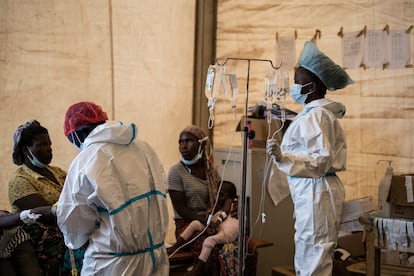Infectious diseases study highlights inconsistent reporting and importance of the human factor
A new report has unified the WHO threat prevention model, after reviewing nearly 3,000 documents issued over the 23 years leading up to the Covid-19 pandemic

Until now, no official pandemic model had been capable of recording the health alerts that are reported around the world on a daily basis, which sometimes number tens of thousands a day. The Covid-19 pandemic accelerated a unifying process that had been underway for years but had yet to be fully developed. Now, a group of scientists has developed a database based on previously unreleased World Health Organization (WHO) Disease Outbreak News (DON) statistics, a system which allows any physician to report possible health threats from anywhere in the world. It also provides a detailed review of epidemic outbreaks over the last two decades, up to the months leading up to the global outbreak of the coronavirus pandemic.
The authors point out that their work with the historical record allows them to observe recurrent threats at the global level, such as influenza or cholera, and persistent epidemics, such as the Ebola virus disease in Africa or MERS-CoV in the Middle East. However, the report also highlights the issues raised by inconsistent reporting of factors such as disease names, case totals, mortality, and actions taken to curtail the spread of illnesses. “Egypt, with 115 health alerts, has the fifth-highest number of notifications and a strong yellow fever track record, while neighboring Libya has never reported anything, reflecting the collapse of its once highly effective health system after two civil wars,” says Rebecca Katz, director of the Center for Global Health Science and Security at Georgetown University Medical Center and lead author of the review, which covers the period from 1996 to 2019.
Among the information collated in the report, China stands out with the highest number of health alerts (262), most of which are related to different types of influenza. Katz notes the coincidence between the information collected and the accuracy with which epidemics have been recorded, since despite “lost protocols,” redundant information or problems with mismatching categories, there have been no “unreported” phantom pandemics.

Expert criteria
“The WHO website is the main source of health information,” explains Katz, “so we believe that the official registry should be standardized.” The researcher explains how specialists must “monitor tens of thousands of signals every day that could represent a serious global health problem, and all the time they have to decide what is relevant and what is not.” As such, she considers it vital to design a model that unifies historical criteria on health alerts. The model presented by the Georgetown University team is available online worldwide.
Epidemiologist Susana Monge Corella, who did not participate in the research, highlights another key after analyzing the work: the human role in deciding the severity of an outbreak. In those vital moments, experience is an important factor, she says: “You filter according to accumulated knowledge, but there is no expert committee I have sat on where health alerts were decided without discussion, despite the decades of knowledge. Due to the complexity of decision-making, the human factor is difficult to replace.”
Monge, of the National Epidemiology Center at the Carlos III Health Institute in Madrid and who served on the Spanish Health Ministry’s emergency coordination center during the Covid pandemic, points out that there are other infections where the decision on whether to report or not is made based on the unexpectedness or virulence of the event. “If a family gets botulism poisoning through a homemade product then it is a concrete problem. If a child gets botulism poisoning from a commercial milk formula that has been sold throughout Spain, then the same disease has a completely different risk and takes on another dimension. If the brand of milk formula is from overseas, then it is already an international problem,” the epidemiologist explains.

A case of avian influenza is “priority number one; every event is reportable” and subject to “strict surveillance over the years, hence its prevalence in the study,” Monge adds. Hence the alarm generated by an outbreak in October among mink in Spain’s northwestern region of Galicia, which has placed virologists around the world on high alert, even though it has not jumped to humans.
Dangerous influenza outbreaks are the main disease reported in the 23 years analyzed, with 776 notifications. The most recent recorded case, on January 18, was a case of avian influenza in a nine-year-old girl in Ecuador. Because of its prevalence over decades and its severity, the Georgetown scientists emphasize that they have unified the different subtypes of influenza, taking into account that the WHO requires reporting of new variants in accordance with International Health Regulations. In an accompanying commentary, the researchers state that while the number of influenza cases has increased globally, due to its pandemization it is underreported, distorting certain parameters. The authors are aware of thousands of influenza A infections in Iran in 2019 and India in 2015, but over the last decade the only reports on influenza A outbreaks - beyond three isolated and minor cases in Canada, Laos and the Netherlands - have come from China.
The Georgetown researchers reviewed 2,789 WHO disease outbreak news reports, recounting relevant information about unexpected epidemic outbreaks such as the 2014-2016 Ebola virus outbreaks in West Africa or the 2011 cholera outbreak in the Democratic Republic of Congo. In these can be read “high-level decision making that governs information sharing during public health emergencies,” the researchers explain in the paper. This is why the report concludes that more information transparency and the adoption of “standardized formats for sharing epidemiological metadata” would make the DON “more useful to researchers and policymakers.” Despite this, the report acknowledges a palpable improvement in the WHO health alert register due to the new normality imposed by the pandemic.
In theory, all healthcare professionals should report a possible infectious outbreak to the WHO on the mere suspicion of a case. An epidemic outbreak alert is anything that could “pose a risk to public health,” says José María Arteagoitia Axpe, a specialist in preventive medicine and public health. The rapid transmission of information is essential, adds the expert, given that the objective of the epidemiological surveillance system is “the detection and control of communicable diseases”
Sign up for our weekly newsletter to get more English-language news coverage from EL PAÍS USA Edition
Tu suscripción se está usando en otro dispositivo
¿Quieres añadir otro usuario a tu suscripción?
Si continúas leyendo en este dispositivo, no se podrá leer en el otro.
FlechaTu suscripción se está usando en otro dispositivo y solo puedes acceder a EL PAÍS desde un dispositivo a la vez.
Si quieres compartir tu cuenta, cambia tu suscripción a la modalidad Premium, así podrás añadir otro usuario. Cada uno accederá con su propia cuenta de email, lo que os permitirá personalizar vuestra experiencia en EL PAÍS.
¿Tienes una suscripción de empresa? Accede aquí para contratar más cuentas.
En el caso de no saber quién está usando tu cuenta, te recomendamos cambiar tu contraseña aquí.
Si decides continuar compartiendo tu cuenta, este mensaje se mostrará en tu dispositivo y en el de la otra persona que está usando tu cuenta de forma indefinida, afectando a tu experiencia de lectura. Puedes consultar aquí los términos y condiciones de la suscripción digital.
More information
Archived In
Últimas noticias
Most viewed
- Sinaloa Cartel war is taking its toll on Los Chapitos
- Reinhard Genzel, Nobel laureate in physics: ‘One-minute videos will never give you the truth’
- Oona Chaplin: ‘I told James Cameron that I was living in a treehouse and starting a permaculture project with a friend’
- Why the price of coffee has skyrocketed: from Brazilian plantations to specialty coffee houses
- David King, chemist: ‘There are scientists studying how to cool the planet; nobody should stop these experiments from happening’










































